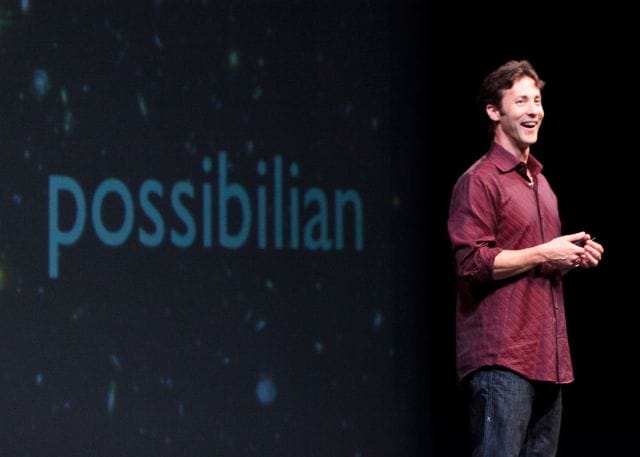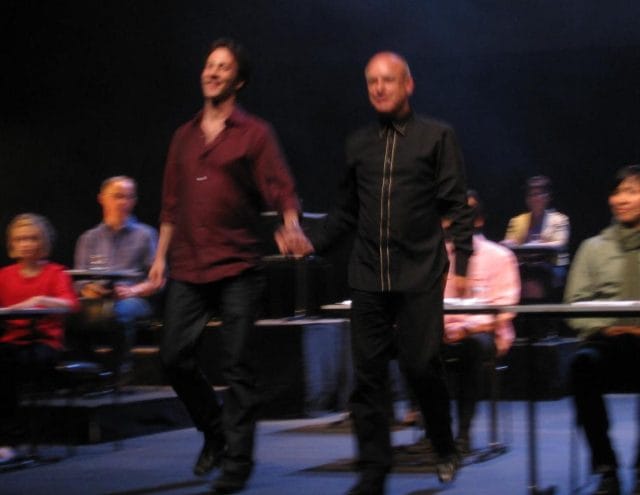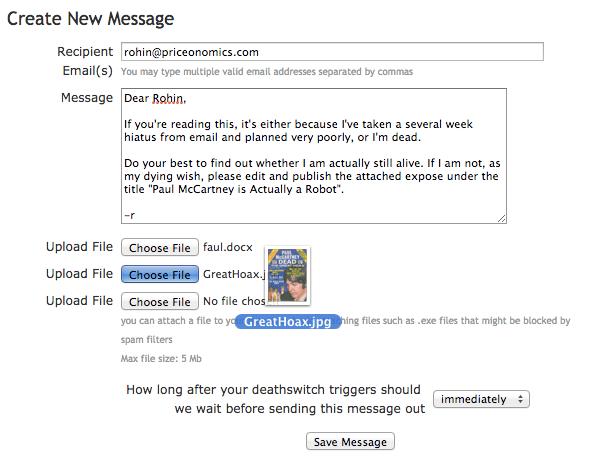
David Eagleman at TEDx Houston, 2010
In 2006, science fiction writer David Eagleman had a question: When you die, what happens to your stuff?
You can will away a lot of your possessions: your couch, your pog collection, even your royalties. But what happens to your digital stuff: email inboxes, social media accounts, the family recipe for spam casserole? What about the stuff nobody else knows exists at all, like your tell-all memoir buried in the nether regions of a server, locked under a password that only you know? What if you die suddenly before handing it over? In the future, as people accumulate more and more digital property, what will happen to that property when they die?
Eagleman wrote a short story outlining a possible solution, titled “A Brief History of Death Switches”:
“At the beginning of the computer era, people died with passwords in their heads and no one could access their files. When access to these files was critical, companies could grind to a halt. That’s when programmers invented death switches.”
“With a death switch, the computer prompts you for your password once a week to make sure you are still alive. When you don’t enter your password for some period of time, the computer deduces you are dead, and your passwords are automatically e-mailed to the second-in-command. Individuals began to use death switches to reveal Swiss bank account numbers to their heirs, to get the last word in an argument, and to confess secrets that were unspeakable during a lifetime.”
It turns out that the problem Eagleman imagined is real, and it goes beyond those of us who have secret Swiss bank accounts or forgotten life insurance policies. A solution very similar to the one Eagleman imagined is also real. Some people program their own switches, but if you’re not so gifted or so motivated, you can subscribe to a service provided by Deathswitch.com:
“Deathswitch prompts you for your password [via email] on a regular schedule to make sure you are still alive. When you do not enter your password for some period of time, the system prompts you again several times. With no reply, the computer deduces you are dead or critically disabled, and your pre-scripted messages are automatically emailed to the individuals you designated.”
If this sounds like it was lifted directly from Eagleman’s story as we quoted it above, it’s because it was. Deathswitch is the property of Information Immortality LLC, which was founded in 2006 by David Eagleman.
Just That Kind of Guy
It is at this point that we should mention that David Eagleman is a very special person.
That short story, “A Brief History of Death Switches,” was published in Nature. This is kind of like an artist being asked to perform at the White House. Nature is a prominent scientific journal that mostly publishes research. Actual scientists read it — lots of them. In 2009, he published it again as a chapter in his first book, Sum. It was one of the book’s 40 different interpretations or imaginings of “life” after death. After the book came out came out, he and Brian Eno performed a musical reading of it at Sydney Opera House.

David Eagleman and Brian Eno, holding hands — Sydney Opera House, 2009
In addition to being a best-selling author, Eagleman is a neuroscientist. His professional mentor, Sir Francis Crick (of Watson and Crick, the DNA-molecule-discovering, Nobel-prize-winning team) once advised him, “The dangerous man is the one who has only one idea, because then he’ll fight and die for it. The way real science goes is that you come up with lots of ideas, and most of them will be wrong.”
Eagleman certainly has lots of ideas. As a New Yorker writer profiling him reported of his professional life in 2011:
“One of his nine lab members was studying the neurological roots of empathy; another was looking at free will. Two were studying timing disorders in schizophrenics; one had helped create the world’s foremost database of synesthetes. Eagleman had projects on epilepsy, counterfeiting, decision-making in courts, and timing deficits among brain-damaged veterans of Iraq and Afghanistan, as well as four books at various stages of completion.”
The article also mentions Eagleman’s expertise on a furry-looking little insect called the asp-caterpillar. One stung him in 2004, so he spent the next few years pulling together a report on the insect, including a comprehensive history of attacks and the symptoms displayed by victims. He published this report in Clinical Toxicology in 2007.

Never, ever touch one of these: symptoms of contact include “burning pain, swelling, nausea, and itching.”
“He’s the kind of guy who likes to jump on an idea,” Information Immortality’s second-in-command, Sean Judge, told us. “He’ll say, ‘I’ve got to make sure that’s out there!’ or ‘This sounds interesting why don’t I make it?’” Eagleman has a lot of ideas, and it seems he acts on more of those ideas in a week than many of us do in a lifetime.
Knowing this, it makes more sense that when Eagleman the writer thought of Deathswitch, Eagleman the technologist decided to make it more than fiction.
A History of Actual Death Switches
Eagleman’s Deathswitch is an instance of a “dead man’s switch”:
A switch that is automatically operated if the human operator becomes incapacitated, such as through death, loss of consciousness or being bodily removed from control.
The concept was coined for the mechanism — which is still in use — to prevent runaway subway trains and cable cars. In order for the vehicle to move, the driver has to continuously press a button or a lever. If the button is released, in the event that the driver has a heart attack, say, or is unexpectedly assassinated, the vehicle’s brakes are applied automatically.

Runaway transit can cause some real damage, as the public discovered in the Malbone Street Wreck of 1918
This is a “fail-safe” application of a dead man’s switch — these switches exist so that if the human element of a mechanism “fails” (dies), everybody else is still safe. According to Wikipedia, fail-safe dead man’s switches are used in “locomotives, aircraft refuelling, freight elevators, lawn mowers, tractors, personal watercraft, outboard motors, chainsaws, snowblowers, tread machines, snowmobiles, and many medical imaging devices.”
But a dead man’s switch does not have to be an instrument for good. Towards the end of some movies, villains with doomsday devices will clench a button in their hand, and announce they’ve just armed their weapon. If they release the switch, as they are likely to do if shot, the world will be destroyed. This type of switch has been termed the “deadly-safe” dead man’s switch, which is a lot of death for one sentence. For periods of the Cold War, Russia implemented one such “deadly-safe” dead man’s switch called the “Dead Hand” program which allowed for automatic launch of nuclear missiles should it ever stop receiving a suppressing signal from headquarters.
Deathswitches can trigger just about anything. Eagleman’s Deathswitch isn’t necessarily “fail-safe” nor “fail-deadly”. It could be either of these, or something else entirely, depending on the deceased’s motives, cunning, and imagination.
Eagleman’s Deathswitch emails its users at regular intervals, asking them to enter their passwords to confirm they are still alive. When a user fails to respond to enough of these prompts in a row, Deathswitch assumes the user is dead. It then takes the messages the user had stored in his account, and forwards them along to the addresses he had specified. The user might have written directions to a buried treasure in these messages, or apologized for his failings, or commanded his hunch-backed sidekick to press the button, or attached a photo of his cat — it’s all up to him!

A message the author drafted using Deathswitch
The Autonomous, Automatic Death Switch
“David doesn’t keep figures,” Sean Judge told us, “like on how many clients we have.”
Deathswitch operates on a freemium model. There’s a free version of the service that Judge says “many thousands” of people subscribe to. Users can opt to pay $19.95 a year to upgrade to the premium package, allowing their switch to trigger an unlimited number of messages, to which they can attach very large files (secret wills, for example). Theoretically, someone could reverse-engineer the number of premium users from Information Immortality’s total annual revenue, but Judge said he didn’t have that figure on-hand either.
“The money is mostly to fund the website hosting and other maintenance costs,” Judge said. “If there was any surplus I’m sure David would just put it back into the lab. He didn’t do it for the money.” The website also updated its original, Flash-based landing page to HTML5 this past year. Judge says this is one of very few changes Deathswitch has undergone since Eagleman created it.
“There’s very little work to do,” Judge said, laughing. “It’s basically a two man operation.”
In addition to his involvement at Information Immortality, Judge also manages Eagleman’s research laboratory, “and his calendar, and his author life.” He and Eagleman are close friends. They met about a decade ago, when Eagleman dated somebody in Judge’s theater group. His job as Eagleman’s general-purpose assistant in part helps supplement Judge’s stage and screen acting career. He says that all this still leaves him with plenty of time for his Deathswitch duties.
“Aside from the occasional programmer we hire,” Judge said, “I’m in charge of maintaining things. That’s mostly customer support.”
Judge says that every once in a while he gets emails from people who are confused about how to schedule thier prompts, or attach a file. “Very, very rarely,” he says he’ll hear from someone whose switch was triggered by mistake, and who accidentally announced his own death — and maybe released many of his secrets — to many of his loved ones without actually dying.
“That’s when I go into the database and see that all ten warning emails were sent and I have proof that they were,” Judge said. Deathswitch’s management may be clueless, and most of its userdata may be encrypted, but it does keep a record. “And then the user will check their spam folder.”
Sometimes email clients mark the prompts as spam, which is something users have to keep track of on their own. “We have no control over that,” Judge said. If they’re used to getting a prompt every ten days, it seems that most people notice if it suddenly stops coming. Then, it’s between them and their email client. “In those cases all we can tell them is, ‘We’re sorry!’” Judge said, mentioning again, “this happens very, very, remarkably rarely.”
Deathswitch has had plenty of competitors over the years, and most have offered more “bells and whistles” than Judge and Eagleman do. Earlier coverage of these companies called dead man’s switches for digital information a “tiny industry”, and rounded up the players in the space. Some had staff on-hand to investigate each death before releasing information. Others monitored public and government databases. All of them charged more, and, since the articles were written in 2009 and 2010, almost all of them have pivoted, changed ownership, or disappeared. These are not ideal turns to take if your clientelle is counting on your product lasting their lifetime, and then some.
Deathswitch, with its simplicity and unknown but probably meagre profit margins, has proven much more robust. It’s ownership is not costly enough, nor monetarily valuable enough to sell. “There was a time when David thought, ‘Maybe I should try to sell this to another company,’” Judge said. “But in the end it’s really not worth it because it’s such an easy thing to run. It’s kind of self-regulating.”
Judge and Eagleman don’t advertise. Remember the story Eagleman wrote? Many clients find Deathswitch after reading that story in Nature or in Sum and their curiosity is piqued. They Google, “death switch”, and are surprised to discover that the product actually exists! Deathswitch has come remarkably close to the technology in, “A Brief History of Death Switches.” Eagleman has made a tool so low-maintenance that it could very easily survive him by decades, or — he might even hope — centuries.
In the story, after widespread use of death switches catches-on, people’s use of the technology takes a sharp turn. First they start using it to schedule messages long after their own deaths:
“Happy 87th birthday. It’s been 22 years since my death. I hope your life is proceeding the way you want it to.”
Then they start using it, and other already existing technology (e.g. auto-reply algorithms, fax machines), to pretend to be alive. And they get very good at it.
Ultimately, the narrator predicts, all that will be left of humanity is a vast network of these switches — bouncing messages back and forth. Inside jokes, poignant words of kindness or affection, excuses for not coming into work for the ten-thousandth day in a row. Some of these are pre-programmed, others machine-learned. “The planet’s memories,” Eagleman wrote, “survive in zeroes and ones.”
This is a beautiful thing, Eagleman’s narrator thinks, “as reminiscing about our glory days of existence is perhaps all that would have happened in an afterlife anyway.”
But this poetic and existentially challenging future is a long ways off: So far, nobody is using Deathswitch to pretend to be alive long after their own death — sending text messages from beyond the grave, or authoring blog posts. At least, we hope not.
This post was written by Rosie Cima; you can follow her on Twitter here. To get occasional notifications when we write blog posts, please sign up for our email list



